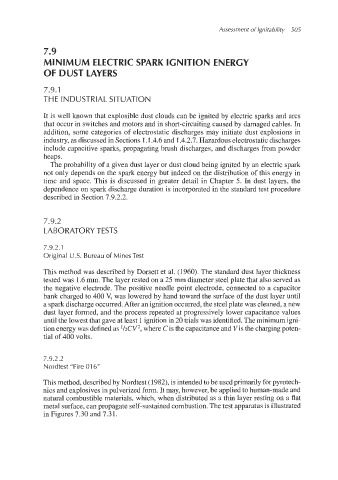Page 538 - Dust Explosions in the Process Industries
P. 538
Assessment of lgnitability 505
7.9
MINIMUM ELECTRIC SPARK IGNITION ENERGY
OF DUST LAYERS
7.9.1
THE INDUSTRIAL SITUATION
It is well known that explosible dust clouds can be ignited by electric sparks and arcs
that occur in switches and motors and in short-circuiting caused by damaged cables. In
addition, some categories of electrostatic discharges may initiate dust explosions in
industry, as discussed in Sections 1.1.4.6and 1.4.2.7.Hazardous electrostatic discharges
include capacitive sparks, propagating brush discharges, and discharges from powder
heaps.
The probability of a given dust layer or dust cloud being ignited by an electric spark
not only depends on the spark energy but indeed on the distribution of this energy in
time and space. This is discussed in greater detail in Chapter 5. In dust layers, the
dependence on spark discharge duration is incorporated in the standard test procedure
described in Section 7.9.2.2.
7.9.2
LAB0RATORY TESTS
7.9.2.1
Original U.S. Bureau of Mines Test
This method was described by Dorsett et al. (1960). The standard dust layer thickness
tested was 1.6mm. The layer rested on a 25 mm diameter steel plate that also served as
the negative electrode. The positive needle point electrode, connected to a capacitor
bank charged to 400 V, was lowered by hand toward the surface of the dust layer until
a spark discharge occurred.After an ignition occurred, the steel plate was cleaned, a new
dust layer formed, and the process repeated at progressively lower capacitance values
until the lowest that gave at least 1 ignition in 20 trials was identified.The minimum igni-
tion energy was defined as %CV2,where Cis the capacitance and Vis the charging poten-
tial of 400 volts.
7.9.2.2
Nordtest "Fire 016"
This method, describedby Nordtest (1982), is intended to be used primarily for pyrotech-
nics and explosivesin pulverized form. It may, however, be applied to human-made and
natural combustible materials, which, when distributed as a thin layer resting on a flat
metal surface, can propagate self-sustainedcombustion. The test apparatus is illustrated
in Figures 7.30 and 7.31.

